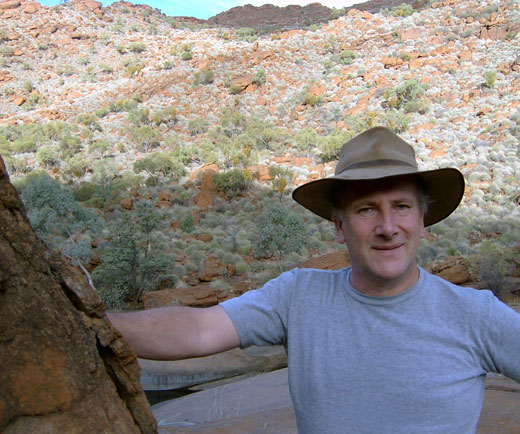Mark
Smerdon currently lives with his wife, Kathy, in the Pitjantjatjara
Lands in the centre of Australia, where he teaches music at one of the
Anangu schools. The Anangu are the people who are indigenous to that
region of Australia. He was born in January 1953 (you do the maths) in
England while his parents were on a working holiday there. This makes
him a citizen of the European Union, even though he speaks with the
usual Aussie accent!
Mark’s formal music training came between the age
of eight and fourteen from Sister Theresa, the very talented music
teacher at his Primary School in Adelaide. She recognised his love of
composition and encouraged it. With such little formal training, Mark
had to pick up what training he could from any source available. His
father’s mother was the pianist at the local (silent) picture theatre
operated by her husband in the 1920s. She was a brilliant pianist who
could sight-read anything perfectly and also play any tune by ear. She
passed this love of music on to her children. Mark’s father played
string bass in the Adelaide Symphony orchestra for about forty years,
which must be an all-time record.
After
leaving school Mark played bass in amateur orchestras and dance bands,
but mainly in small ensembles where he wrote much of the repertoire.
While living in the Snowy Mountains of Australia, he was Composer in
Residence in a country town. Mark’s music is performed by Symphony
Orchestras and ensembles at various international venues and is
occasionally heard on Australian National radio.
Much
of Mark’s inspiration comes from his surroundings, people he loves and
life experiences. Winanga-li is no exception!
“Rainbow Dance” was written in the mountains for Sara’s recorder (blocke-flaute)
lessons.
“Flood” was written there too, as a piano study for some
students that needed to learn some rhythmic forms. The music rushes
along with eddies and currents flowing across each other like the raging
torrents of a river that has burst its banks.
“Memory” is reflecting on
our childhood years, holding the warmth of a parent’s hug or lullaby and
the rapture that so often fills a child’s days and nights.
“Sara’s Soul
Song” is a musical picture of this wonderful angel who came into our
lives as a daughter and is now a true friend and artistic collaborator.
It celebrates how she spreads her angel wings to fly free and show us
the way we could live, if we were only brave enough to join her, to
follow her example of flying to whatever tune calls us forwards.
“Anna’s
Amazing Aria” is a portrait of Sara’s younger sister who is quite simply
a beautiful soul. Anna is one of Sara’s biggest fans and best friend.
What is she doing in this story of Sara? To know Sara and not have met
Anna is not to know Sara.
“Didgeridon’t” is a bit of joke as far as the title goes. But it does
make a point. Like the boomerang, only a few areas of Australia have
this instrument as part of the local culture! The chanting song-line is
more a memory of many chants than one actual chant.
“Heat and Red” is
the pulsing dry oppressive heat that only those who have spent time in a
hot desert will know. You cannot escape the terrifying sun but it has a
certain power of fascination as it grills the life out of you. It bakes
the soil to a bright red, which forms waves across the landscape like a
shimmering red sea of heat.
”Uluru” was written after a visit to the mystical mammoth of a rock of
that name sitting in the centre of Australia. The music is not so much
about the rock itself but more a wonderment at all the birds that come
to this oasis in the desert to eat and drink, to breed, to play and to
sing! Underlying all this is the timeless spiritual power that you can
not help but feel in the presence of this sacred site. The sense of
majesty that the rock gives you when you are standing at its huge base
is somehow emphasised more by all the fun and games the birds get up to
all around it!
Until
Hardy Mertens met Mark’s daughter Sara, to whom this work is dedicated,
Mark’s main outlet for his music was though amateur orchestras, string
ensembles and piano pieces. Hardy asked Sara did her father write
anything to do with
wind.
Sara’s favourite piece of Mark’s music was a piano solo called “Wind and
Tree” (also available from HAFABRA Music), which Hardy orchestrated for
wind symphony. That collaboration prepared the way for the piece you
hear today which is a much more daring collaborative undertaking, with
Mark’s thematic material being reworked by Hardy into the complex and
rich sound you hear today. Sara has described
her
Australia to Hardy, which he has translated into music using the
inspiration of Mark’s tunes and harmonies written in and about Australia.
So, for Mark, this Netherlands connection is an exciting point in his
musical career.
Mark’s
favourite saying is “Why not!”. Why not write music about the land
around you when it is so captivating, why not collaborate with such an
accomplished talent as Hardy Mertens (who has become a good friend along
the way), why not explore this nexus of culture between New Holland and
the Netherlands of today, why not enjoy listening to the best Harmonie
Band with the best conductor perform our collaborative efforts, why not
start work on our next project . . .

